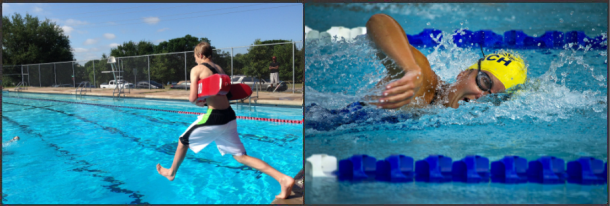Olympic diving is divided into platform and springboard diving. The springboards will be 3 meters high and the platforms 10 meters. The diving event also features synchronized diving.

In total, there are four different diving events. These will be as follows:
– 3-meter springboard diving
– 3-meter synchronized springboard diving
– 10-meter platform diving
– 10-meter synchronized platform diving
The different diving techniques
1. Tuck position

The tuck position is seen as one of the easiest diving positions.
The diver’s knees, in this position, will be tucked tightly against the chest. The hands will be holding the calves. In this position, the diver will have to perform somersaults. The highest possible number of somersaults is four and a half. The more somersaults, the higher the score.
2. Pike position

The second easiest position is the pike.
The diver’s body will be bent, chest pressed against their knees. The legs are extended, with no bending in the knees. The head will be looking in the direction of their pointed toes. Like with the tuck position, the number of somersaults influences the score.
3. Straight position

In the straight position, the body is extended—no bending in the knees. Hands-on, either side held tightly against the body. With a slight bend in the hips forward.
4. Free position

As the name suggests, the free position is where the diver may combine several techniques within their twisting dive.
The different diving positions can be performed using any of these:
1. Forward dive

Take 3-5 steps; you jump up and dive on the last step.
2. Backward dive

The back is facing the water and the diver will face the board. When you jump, your arms should be swung backwards for some force to jump off the board.
3. Reverse dive

With this position, the diver will be facing the pool. The arms are in a T-position. Then using the arms and swinging them in a circular motion, the diver gains some spring to flip the body so that they will face the springboard when they dive.
4. Inward dive

The diver will be standing on the edge of the diving board; the arms will first be in a t-position, then stretched above the head. This should be done with some force to gain spring. Once the diver jumps, they will extend both legs in front, touch the toes and turn so that when they enter the body, their body is in a straight line.
5. Twisting dive

The twisting dive is similar to the inward dive at the beginning. Still, instead of going straight into the pike position, where the diver touches their toes, the diver will twist and then, after the twist, will go into the pike position after the body is extended into a straight line upon going into the water.
6. Armstand dive

As the name states, this dive will be the diver doing an armstand on the edge of the platform or springboard, with their back towards the pool. The head of the diver will be looking down at the pool.
What counts as a good Olympic dive?
The diver should enter the water vertically, with the body extended into a nice straight line, feet together with the toes pointed. If the dive is performed correctly, there should not be a lot of splashes.
However, the judges will give out scores on how the dive is performed. So more important is what happens before the diver reaches the water.
Scores will be given from 0-10.
Olympic diving requires great coordination and top-form athleticism, and the jumps are all performed gracefully. Dives that take years to practice but are performed within a minute. One wrong move and a dive can become fatal.
What once was called plunging is now an established Olympic sport, with an array of diving positions and the number of somersaults performed increasing.
Lifeguard Services
Lifeguard services provide an easy way to hire a fully qualified lifeguard for permanent, short and long-term hire. We offer an easy way to make sure your allocated water is in safe hands. We can come to your school, outdoor event, party and more. To find out more and book, please see our booking page.




Leave a Reply